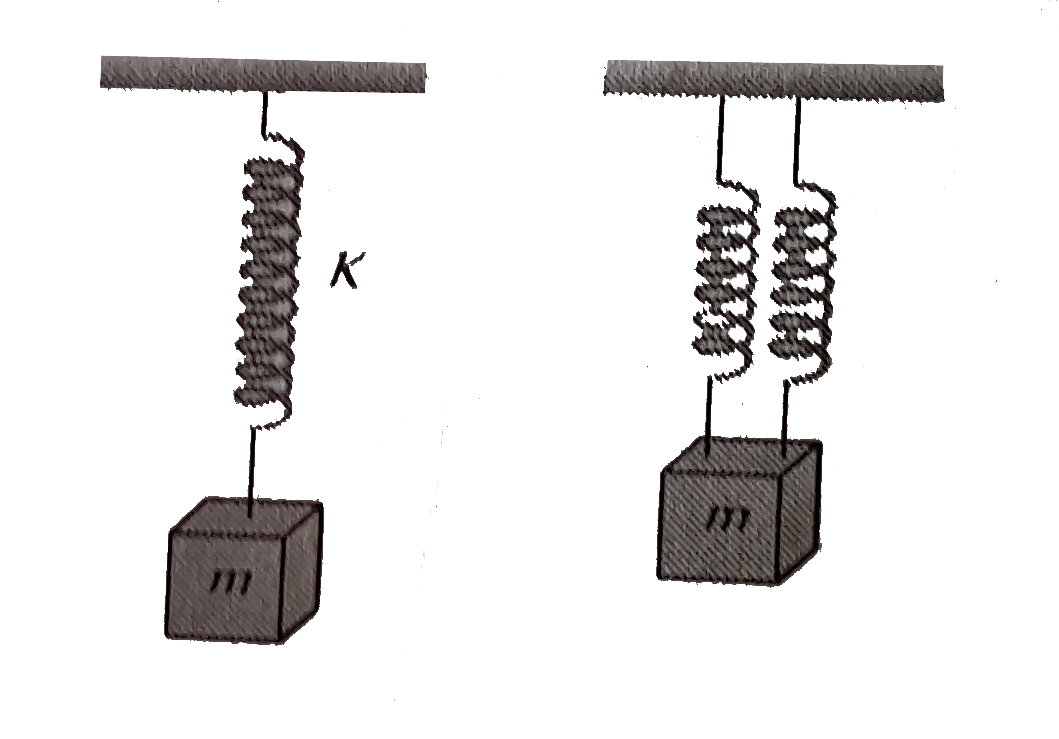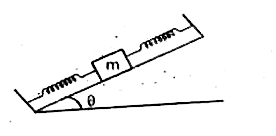Time period of a spring mass system is T.If this spring is cut into two parts whose lengths are in ratio 1:3 and the same mass is attached to the longer part, the new time period will be
√32T
T√3
√3T2
√3T
The correct Answer is:B
To solve the problem, we need to find the new time period of a spring-mass system after the spring is cut into two parts in the ratio 1:3, and the same mass is attached to the longer part. Here’s a step-by-step solution:
Step 1: Understand the Time Period Formula
The time period T of a spring-mass system is given by the formula:
T=2π√mk
where m is the mass attached to the spring and k is the spring constant.
Step 2: Determine the Lengths of the Spring Parts
Let the total length of the spring be L. According to the problem, the spring is divided into two parts in the ratio 1:3. Therefore:
- Length of the first part L1=L4
- Length of the second part L2=3L4
Step 3: Find the Spring Constant of the Longer Part
The spring constant k is inversely proportional to the length of the spring. Thus, if the original spring constant is k for length L:
k1=kLL1=kLL4=4k
for the shorter part, and for the longer part L2:
k2=kLL2=kL3L4=4k3
Step 4: Calculate the New Time Period
Now, we will calculate the new time period T′ using the spring constant k2:
T′=2π√mk2=2π√m4k3=2π√3m4k
Step 5: Relate the New Time Period to the Original Time Period
We know from the original time period T:
T=2π√mk
Thus, we can express T′ in terms of T:
T′=T⋅√34=T⋅√32
Final Answer
The new time period when the mass is attached to the longer part of the spring is:
T′=T⋅√32
Summary
The new time period of the spring-mass system after cutting the spring into two parts in the ratio 1:3 and attaching the mass to the longer part is T′=T⋅√32.
---
The time period T of a spring-mass system is given by the formula:
T=2π√mk
where m is the mass attached to the spring and k is the spring constant.
Let the total length of the spring be L. According to the problem, the spring is divided into two parts in the ratio 1:3. Therefore:
- Length of the first part L1=L4
- Length of the second part L2=3L4
The spring constant k is inversely proportional to the length of the spring. Thus, if the original spring constant is k for length L:
k1=kLL1=kLL4=4k
for the shorter part, and for the longer part L2:
k2=kLL2=kL3L4=4k3
Now, we will calculate the new time period T′ using the spring constant k2:
T′=2π√mk2=2π√m4k3=2π√3m4k
We know from the original time period T:
T=2π√mk
Thus, we can express T′ in terms of T:
T′=T⋅√34=T⋅√32
The new time period when the mass is attached to the longer part of the spring is:
T′=T⋅√32
The new time period of the spring-mass system after cutting the spring into two parts in the ratio 1:3 and attaching the mass to the longer part is T′=T⋅√32.
Similar Questions
Knowledge Check
- Question 1 - Select One
The time period of a spring - mass system is T. If this spring is cut into two parts, whose lengths are in the ratio 1:2, and the same mass is attached to the longer part, the new time period will be
A√13TB√23TC√3T2D√3T - Question 2 - Select One
Time period of a spring mass system can be changed by
Achanging the massBacclerating the point of suspension of the blockCcutting the spring (i.e.changing the length of the spring)Dimmersing the mass in a liquid - Question 3 - Select One
The time period of a mass suspended from a spring is T. If the spring is cut into four equal parts and the same mass is suspended from one of the parts, then the new time period will be:
AT4BTCT2D2T
A body is in SHM with period T when oscillated from a freely suspended spring. If this spring is cut in two parts of length ratio 1:3& again oscillated from the two the two parts separatedly, then the periods are T1&T2 then find T1/T2.
View SolutionTime period of a block with a spring is T0. Now ,the spring is cut in two parts in the ratio 2:3. Now find the time period of same block with the smaller part of the spring.
View SolutionA mass m performs oscillations of period T when hanged by spring of force constant K . If spring is cut in two parts and arranged in parallel and same mass is oscillated by them, then the new time period will be
 View Solution
View SolutionThe time period of a mass suspended from a spring is T if the spring is cut in to equal part and the same mass is suspended from one of the pert then the time period will be
View SolutionA uniform spring has certain mass suspended from it and its period for vertical oscillation is T1. The spring is now cut into two parts having the lengths in the ratio of 1:2 and same mass is suspended with those two spring as shown in figure. Now time period is T2. The ratio T1/T2 is
 View Solution
View Solution

